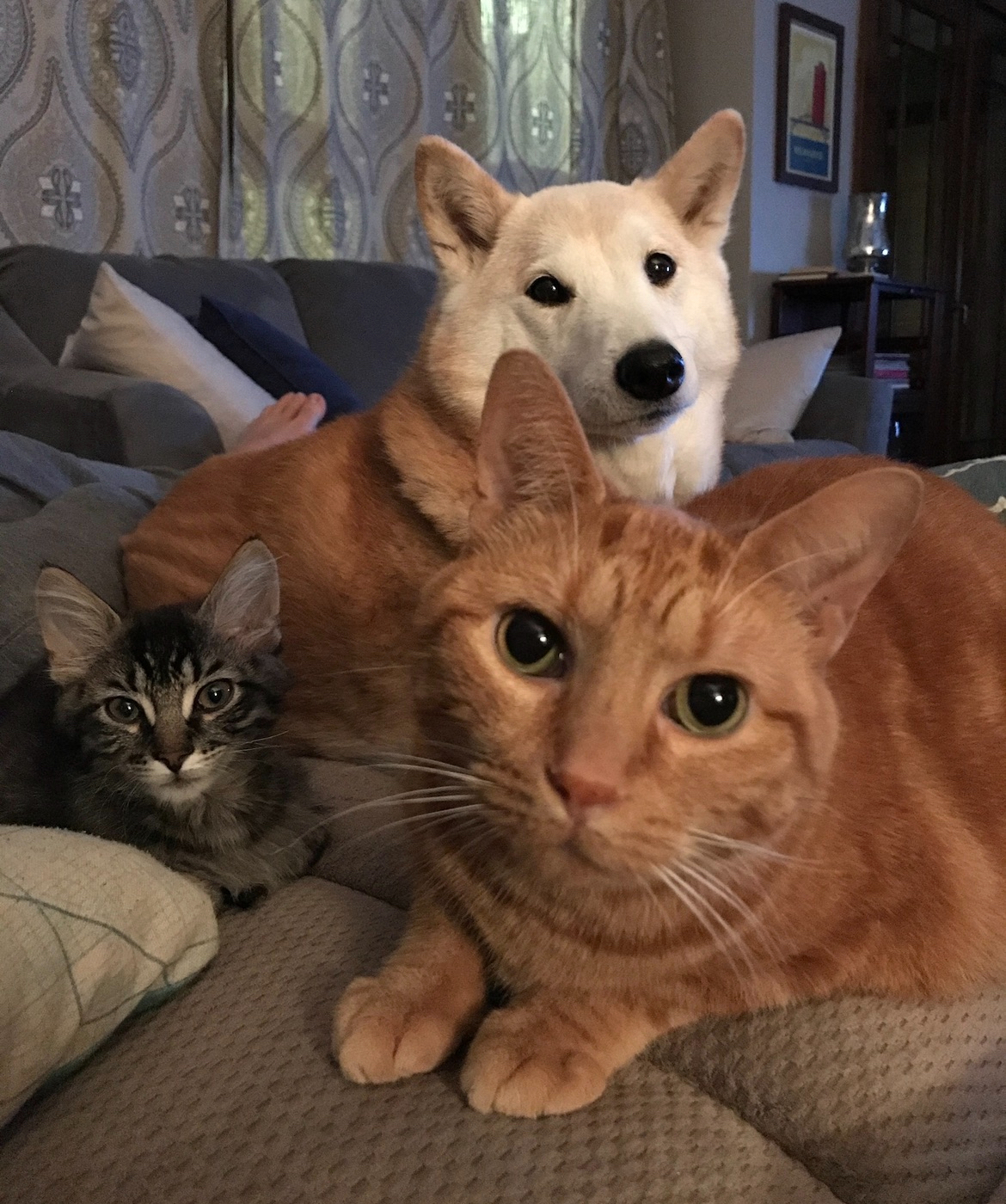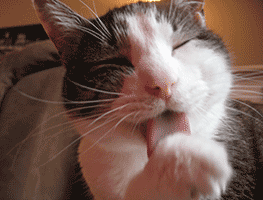Introducing Cats to Dogs
 Bringing a new animal into a home when you already have pets can be exciting, but also potentially stressful on all the animals involved. Whether you are bringing home a new dog and have a resident cat or if you are bringing home a new cat and have a resident dog, it is important to take precautions and perform slow introductions. There are many cats and dogs who live successfully together in homes, but some cats and dogs are unable to coexist successfully due to their individual personalities and dispositions. Unfortunately, dogs and cats can cause significant damage to one another if introductions go wrong, so it’s crucial to do some advanced planning and preparation before they meet.
Bringing a new animal into a home when you already have pets can be exciting, but also potentially stressful on all the animals involved. Whether you are bringing home a new dog and have a resident cat or if you are bringing home a new cat and have a resident dog, it is important to take precautions and perform slow introductions. There are many cats and dogs who live successfully together in homes, but some cats and dogs are unable to coexist successfully due to their individual personalities and dispositions. Unfortunately, dogs and cats can cause significant damage to one another if introductions go wrong, so it’s crucial to do some advanced planning and preparation before they meet.
Even if the animals have lived with other species and done well in the past, proceed with caution; just like with humans, every individual pairing is different and compatibility will vary. It is always best to have two people present during introductions. If you have more than one cat or dog, be sure to introduce them each to the new pet separately.
Before going forward with cat-to-dog introductions, read through the following resources so you are fully prepared and set up to bring your new companion home:
- Cat Body Language
- Dog Body Language
- Setting your Cat/Dog Up for Success (depending on which animal is the new pet)
Finding a Good Match
The first thing that will be important is finding a good match for your resident pet. If you are looking at adding a dog to your home and already have a cat, it may be easier to bring home a younger dog versus an older one, or adopting a dog who has a history of living successfully with other animals. If you want a dog who will be trustworthy around small animals (such as gerbils, guinea pigs, or rabbits), you’re generally better off starting with a puppy and raising them to know appropriate behavior around these species. It is much more challenging to change inappropriate behaviors and associations in an adult dog than it is to create appropriate ones in a young dog.
If you have a dog who obsessively barks, growls, lunges, attempts to chase, pin, pick up, or bite at cats, we recommend they live in a cat-free home. If you still decide to bring a cat into your home, you will need to have a management plan in place and proceed with extreme caution. It will also be important that you work one on one with a certified, force-free trainer to ensure everyone’s safety. Likewise, if you have a cat who growls, swats, runs from, or hides from dogs, even after a slow introduction, consider if your cat will really enjoy living with a dog or if it will just increase their stress, which may in turn cause other behavior issues or increase the severity of existing ones.
If you have a dog who loves to play by chasing things, including small animals, a shy cat who runs away or an energetic cat who runs and pounces may not be the best fit. These cats may trigger the dog to chase, which can lead to escalation of the behavior and potential injuries. A better match for this type of dog would be a calm, confident cat who will not run in fear or play.
For homes with elderly or anxious resident pets, it would be best to match them up with a laid-back, calm animal. Energetic and rambunctious pets may bother, hurt, or frighten the other pet. They can also cause more stress, which can also affect an animal’s health and well-being.
Management
The first step in the introduction process is management – this means setting up the environment to prevent a certain behavior or interaction before it starts, avoiding situations where either animal is able to do something you don’t want. Good management requires barriers, such as doors and/or baby gates, crates or pens, leashes, and supervision. If you have children who may forget to close doors and gates, or animals who know how to open doors or jump over gates, you will need to be sure to add extra management such as self-closing springs, child-proof latches, or locks. You can also look into acquiring extra tall gates or stacking two existing gates on top of each other vertically. Consider the make-up of the gate itself, as well – gates with cross-hatching grid patterns can become easy climbing walls for small paws, while gates with closely aligned vertical bars are much harder for pets to scale. Having a foolproof management plan will be important. Management will not only keep your pets separated safely during the initial introduction period, but it can also prevent the dog from going into a full chase sequence. Chasing is extremely rewarding to the canine brain and if they get a taste of it initially, they will be more likely to do it again. A dog’s desire to chase something that moves is an innate, hardwired behavior, meaning it does not have to be learned. There are some dogs who are bred for this and therefore have a stronger genetic propensity to practice the behavior. If you have a dog who obsesses over the closed door that a cat is behind, you will need to increase management to keep them far away enough from the door. This might require extra gates blocking off access to hallways leading to the room the cat is in. Cats should also always have high-up places to escape to if needed. Be sure to set up plenty of spots for your cat to retreat to or jump up to where the dog cannot reach them. This cat be a taller cat tree or just strategically arranged furniture that allows the cat to jump, for example, from a couch to a mantel, or a chair back to a ledge.
Getting Started
- Confinement | It will be important that both pets are kept separate initially. Depending on the individual animals, plan to have them separate for 3-4 days. Confine your new pet in a safe room with the door closed or on a separate floor of the house. This room should provide all essential items for your new pet, like food, water, toys, a litter box (if applicable), and a bed/crate. All essential information for setting your new pet up in your home can be found in our resources on setting your cat up for success and setting your dog up for success. Do not move on to the next step of the introduction process until your new pet is displaying relaxed body language in their safe space.
- Swap scents | Get both pets used to each other’s scent. Put down an old t-shirt or towel where your pets sleep for them to lay on. Once their scent is on these items, swap the items and put them in the other pet’s area. Do not set the scented items on the other animal’s sleeping place, simply put it somewhere in the open for the other pet to investigate on their own time. Once both animals are completely comfortable with each other’s scent, you can move to the next step. Remember, the key is to go slow and proceed with caution.
- Structured introductions | After your new animal has decompressed and your resident animal has adjusted to the new change, you can begin initial introductions. The key is to go slow, especially if you do not know how either pet will do with the other species. Initial introductions should be done at a distance and focused on creating positive associations with each other. This means that your pets should not come nose-to-nose right away, and neither of the animals should be let loose into the room with the other one. These introductions may need to be adjusted to better fit what you can execute in your home. Two people will most likely be needed (and is highly recommended) in a majority of cases in order to keep everyone safe and as stress-free as possible. Here are a couple of scenarios that could be executed:
-- Create distance between the two animals by having your cat on one side of a gate and having your dog leashed on the other side. Both animals should be at a distance where they are aware of each other but are not reacting or showing signs of stress by barking, whining, becoming hyper-focused, hissing, spitting, or trying to escape. While both animals are relaxed but aware of each other, begin to feed a steady stream of high-value treats to each of them (this is partly why it’s ideal to have two people involved, so each animal has one human’s full attention). These sessions should be kept short and sweet; after a few minutes, either someone should leave the area with the cat or the dog so they can no longer see each other. As soon as they are no longer in eyesight of each other, the stream of food should stop. If at any point either animal stops eating the food, stop the interaction and try again later with increased distance between the two. Repeat this process several times and give both animals a break between sessions. Over time, you can slowly decrease the distance between the two animals as long are they are both showing relaxed body language and taking the treats. The food is not a distraction, but rather a way to change your pet’s response to one another and build positive associations. For example, instead of thinking “I need to chase,” your dog will start to see the cat and think “I get rewarded!”
-- If you do not have the option to separate the animals using a gate, you can have the cat in a room where they are safely perched on top of a cat tree or other tall surface. Enter the room with the dog on leash (do not close the door) and keep the distance between the two animals as far away as possible. Feed both animals a steady stream of high-value treats. If the cat panics and tries to run, do not force them to stay. They are letting you know they are not ready for this step or this close of an interaction. Quickly get the dog’s attention with a handful of treats, move away from the running cat if possible, and continue to distract them. If the dog is so excited that they refuse high-value treats (ex. cooked chicken, hot dogs, meatballs, etc.), they are also not ready for this step.
-- If both of these steps are too overwhelming for either of the animals, you can take it a step back and focus on rewarding the cat or dog for moments when they calmly acknowledge the presence of the other. For example, if the dog is in the room with you and hears the cat vocalize or make noise from the other room, immediately offer a high value treat. It is ideal that you are able to give the treat before the dog gets up and goes searching for the source of the noise. Feed multiple treats to keep their attention on you and away from the cat. You are teaching the dog that the presence of the cat means good things (treats) and paying more attention to you – even when the cat is nearby – is more rewarding. You can do the same for a cat that may hiss, growl, or attempt to hide when they hear the dog from another room or from behind a door. You can also attempt to feed both animals their meals or a stream of high-value treats while they are on opposite sides of a closed door. Keep in mind that having the animals this close, even with a door in between, may cause either pet to go over their threshold of tolerance. If this is the case and either pet is showing signs of stress, not eating, or hyper-focused, you should not proceed using this specific method. - Managed interactions | Once both animals can be near each other in close proximity with no signs of stress, frustration, or increased arousal, you can begin to ease into regular, relaxed routines with the two animals in the same room. In regard to dogs who may have been initially overly interested in the cat, this step can be taken once the dog begins to offer attention to you instead of the cat when the cat is present. It is important to still use as much management as necessary to prevent a dog from being able to chase the cat. You can do this by having the dog drag a leash or tethering the dog to a sturdy piece of furniture near you, offering enrichment like a stuffed Kong (as long as your dog does not have a history of resource guarding and the cat is not likely to confidently approach the dog while engaging in the item). Remember, you don’t want to give your dog the opportunity to chase or rush up to the cat, as the more often they get to practice that behavior, the more desirable and rewarding it becomes.
Once you begin to feel confident in your pets’ behavior around each other, you can reduce the amount of physical management like leashes and tethers. Continue to reward both pets for good choices and immediately interrupt any interactions that may lead to high-intensity chases, increased stress, or aggression. If you have a cat who is pestering the dog and the dog is uninterested in interacting, interrupt the interaction as you would with a dog by engaging the cat with a play session or other interactive toys. It is important that the cat always has access to high places, an escape route to exit the room if needed, and a dog-proof sanctuary at all times. Be prepared to manage your pets’ interactions for several weeks, if not longer. Even if things continue to go smoothly, remember that pets should not be left alone together if you are not there to supervise.
Fighting Like Cats and Dogs?
If introductions don’t go smoothly, you can contact a certified, force-free trainer for an in-home behavior consultation to help you work through a more personalized introduction process or behavior modification plan. Animals can be injured in fights, and the longer the problem continues, the harder it can be to resolve. It is possible for conflicts between pets in the same family to be resolved over time with professional help. As always, punishment to either animal should be avoided, as it can make matters worse. It is important to remember that all animals are unique with their own personalities, behavior quirks, and histories. Some introduction processes can take weeks or even months depending on the animals. It’s also important to acknowledge that not all animals are compatible with one another and some are unable to live with other pets, especially of a different species.
By following the steps detailed above, staying persistent and diligent with your training sessions, and giving both animals plenty of grace and patience, you’re setting everyone in the home up for the best chance at success and most families will see great results!

